On the Chase…
[NOTE: We all have opinions on the Chase and how NASCAR handles its duty to decide a champion. This entry is intended to establish whether the current postseason mechanism increases overall household television ratings for the Cup Series. It is not designed to critique any points system that NASCAR has used -- past or present.]
From 1972 through 2003, the system for determining a season-ending champion for NASCAR’s top series was elegant. Points were awarded to each driver in each race based on finishing position (with small bonuses for lap leaders). The driver with the most points amassed by the end of the year earned the championship. From a competitive perspective, the methodology made sense — all teams competed against the same opponents every week (aside from one-off teams and substitute drivers). Additionally, every team faced the same schedule. There were no conferences, divisional standings, or home-and-away matchups. In other words, a playoff was not necessary because externalities such as “strength of schedule” and “home-field advantage” were non-existent. The declared champion was simply a by-product of each weekly event’s results. This straightforward method, however, sometimes led to a points-standing “non-story” in the fall. Occasionally, a driver built an insurmountable points lead entering the final stretch of the season. That dominance put to rest any intrigue in the outcome of a year-long title (though plenty of battles throughout the field still occurred).
With the intent of fixing lagging late-season television ratings, NASCAR overhauled its system for calculating a champion after 2003. Instead of a season-long points aggregation, the sanctioning body now opts to use a playoff format that is similar to its counterparts in other professional sports. With ten races to go, the series declares a pre-defined number of eligible participants for its “Chase for the Championship” based off of the “regular season.” At that juncture, points acrued by drivers are reset and tightened among playoff participants to guarantee an exciting stretch run. Over the past nine seasons, the rules of the Chase have been tweaked, but the overall premise of a reset-and-sprint to the title remains. In just one sentence, Jim Hunter (NASCAR’s former executive vice president of communications) explains why the Cup Series adopts a postseason format:
We’re doing this to draw additional attention to our sport — that’s the bottom line.
Regardless of whether one agrees with the decision to emphasize entertainment, the objective of the Chase is to attract “additional attention” to NASCAR’s top series. But has NASCAR’s postseason accomplished that after nine years? The goal of this entry is to determine whether the Chase augments the Cup Series’ visibility among television households.
I begin with a look at how the interest in the Cup Series has changed since 1996. I might be able to tell if the Chase affected viewership in 2004 and later. The average rating is colored in black. The Chase was announced prior to the 2004 season, which is where the purple dashed-line is located:
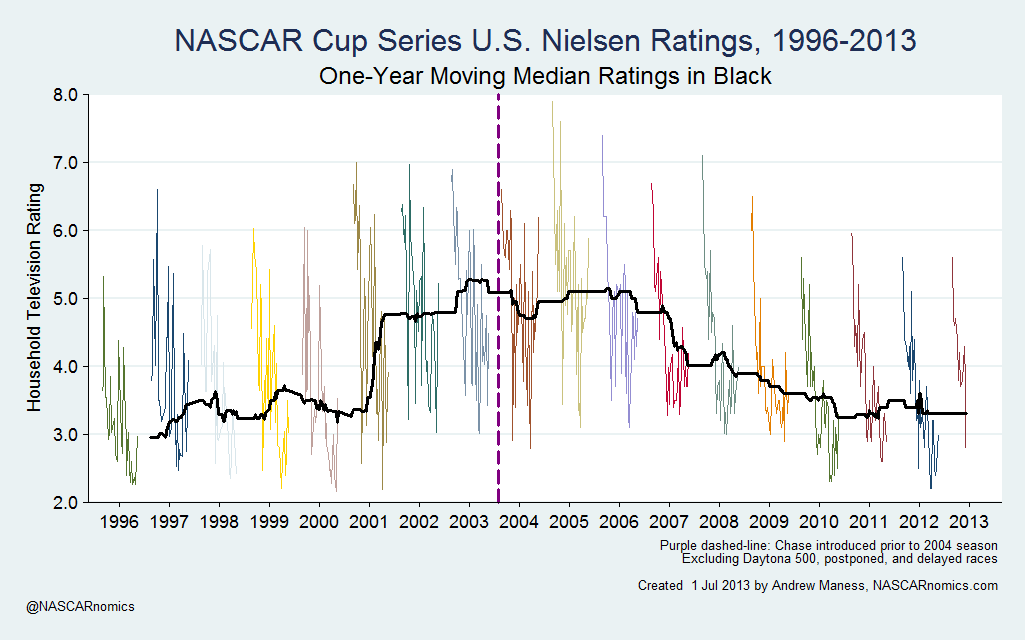
This chart helps a little, but not nearly enough. While I get a sense of how NASCAR’s popularity on television has decreased since the playoff was introduced, it’s difficult to know whether the Chase is mostly, partially, or not-at-all responsible for the major ratings decline in 2004 and later. A bummed economy, a new T.V. schedule with a greater emphasis on cable, and other factors (like track configurations) certainly play a role in that decrease. How much of that negative change can be blamed on the Chase?
So I dig a bit deeper…
I compile each year’s final ten-race median rating (excluding rain delays, of course). The next graph compares the ratings of the final ten races to the corresponding seasons’ average year-long ratings:
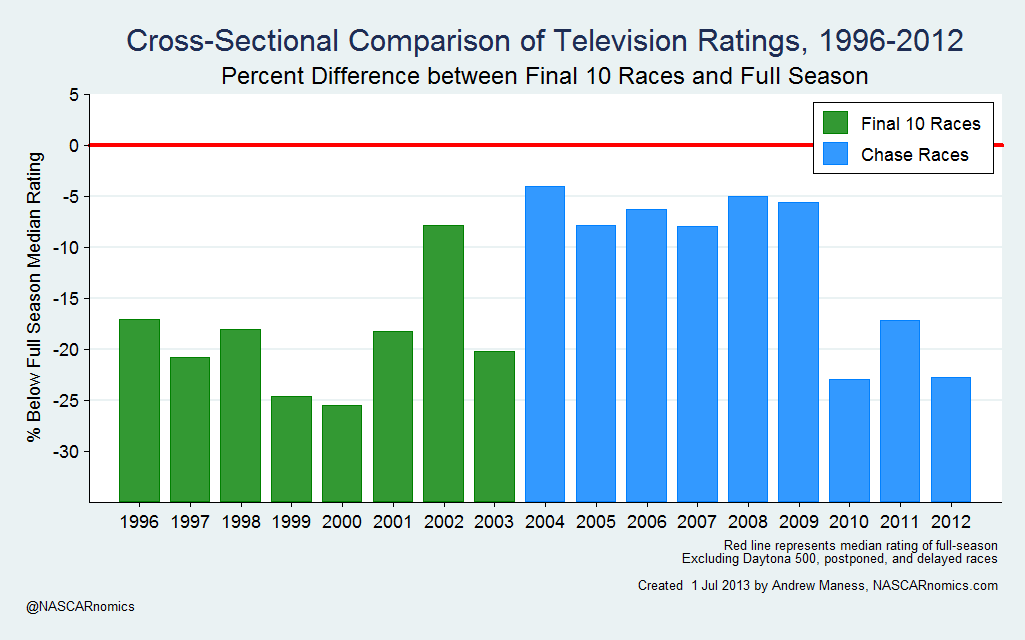
Due to seasonal fatigue and competition from the National Football League, the ratings toward the end of the season are typically much lower than the rest of the season. As a result, each bar on this graph is negative — the taller the bar, the closer the average ten-race rating is to the full season’s median household audience. Thus, one might suggest that the Chase (especially through 2009) boosts the final stint toward the championship. In the eight years preceding the postseason, only 2002 maintained a late-into-the-year segment that is comparable to the Chase’s success.
On the surface, it seems that the Chase adds a nice ratings-grab to the end of the season. Many editions of the playoff garner ratings close to the full-season average. And despite NASCAR’s recent struggles to maintain a robust household audience, the final ten races still perform just as well as in the 1990s.
So that’s it, right? The Chase increases the Cup Series’ television audience? Well, not exactly. I’ve assessed how the implementation of NASCAR’s playoff successfully aids late-season ratings. But how has it affected the “regular season?” In other words, how have the first twenty-six races’ ratings changed since the Chase has been introduced? The following chart demonstrates that the first twenty-six races per year in the 1990s outperform their “Chase-era” counterparts. Once again, the higher the bar, the better the first twenty-six events performed on television:
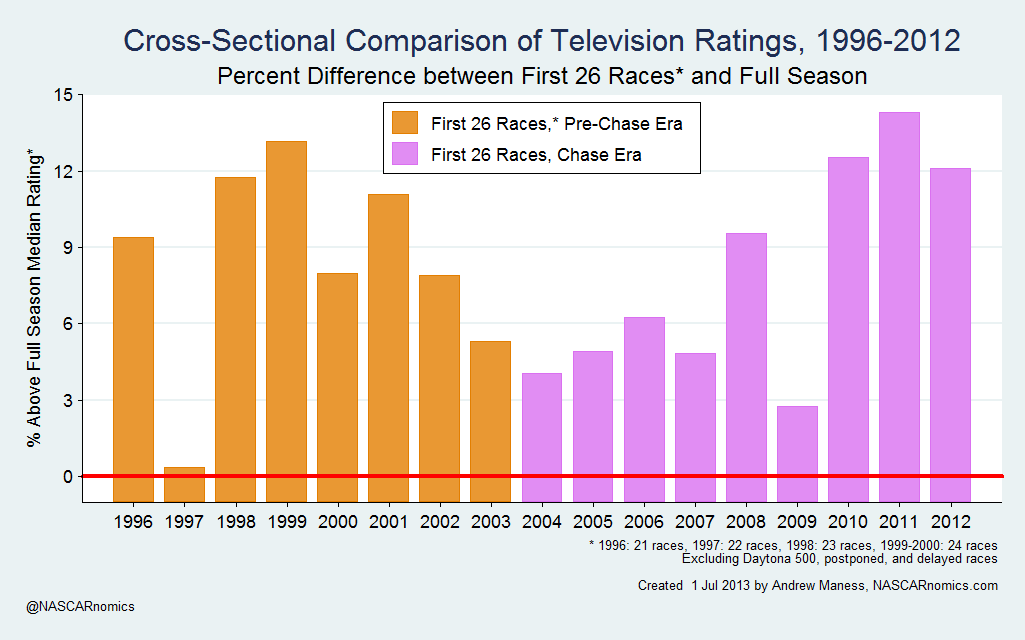
(Feel free to criticize the colors I chose. They’re a bit odd, yes?)
I see that the “regular season” portion of the schedule under-performs in the postseason format. Although the Chase puts NASCAR in a brighter spotlight to end the year, the first twenty-six events lose some luster from 2004 through 2009. Aside from 1997, the pre-Chase era includes ratings that are consistently strong throughout the spring and summer. (Interestingly enough, 2010 through 2012 have produced a “regular season v. playoff” ratings balance that is reminiscent of the late 1990s. Why do you think that is?)
So there’s certainly a trade-off. Judging from the previous two charts, NASCAR’s revised points structure helps the Cup Series’ late-season performance on television. The expense, of course, is that the regular season does not draw as well. And that makes sense — since 2004, the “regular season” counts considerably less toward the championship than previously. Generally, only wins during the first twenty-six events affect the hunt for the title; only the final ten races directly impact the season-ending championship. Before 2004, every race carried equal weight to the final points tally and the variance in ratings from one portion of the season to the next was relatively balanced for that time period. It’s possible that television households might be more interested in events that count directly toward a championship.
To further my point, I attach a line graph that demonstrates how ratings travel within a given season for each time period. After taking into account other characteristics that could fluctuate interest, such as track type, economy, T.V. station, etc.; here are the results:
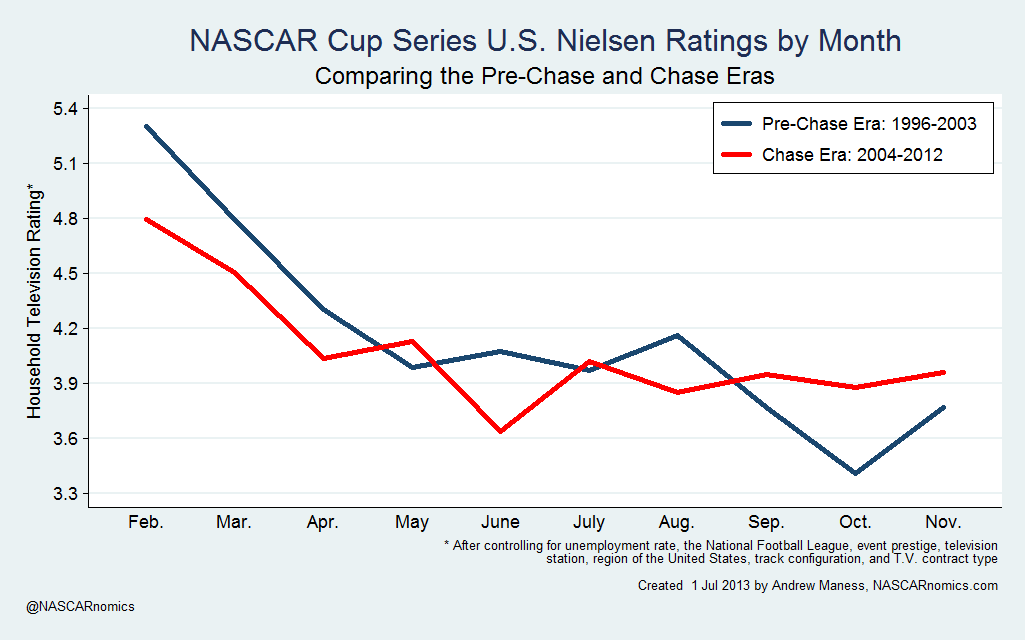
I like this graph. It helps me visualize the change in how races are consumed before and after NASCAR’s Chase implementation. Before NASCAR’s postseason was introduced, the early portion of the season drew a bigger audience. Many drivers would jockey for position in a tight-points battle that would not be reset later in the year. The ratings were consistent throughout the summer and then tailed-off in the fall (though a slight uptick typically occurred in November). Under the current method of deciding a title, early-season ratings follow the same downward trend as the pre-Chase era, but at a lower level. The ratings drop even further in the summer, but the events hold a consistent audience from July through November as teams battle for a playoff berth and ultimately a championship.
The question becomes then — which system provides more viewership over the course of the entire season? We know that the final ten races draw more television households under the playoff format, while the first twenty-six races of the season carried a larger audience before the Chase emerged. But now I explore and find the combined magnitudes of these two systems’ effects on the ratings.
That’s where my model comes in. I can take into account all of those factors that might skew our analysis (track configuration, what time the race begins, the N.F.L., the economy, television network and contract) and isolate the marginal effect that the Chase has had on NASCAR’s Cup Series television ratings. After doing so, here are the results:
 (You can view all variables’ marginal effects on ratings here.)
(You can view all variables’ marginal effects on ratings here.)
I use my outstanding Microsoft Paint skills in the figure above to highlight the numbers that I’m going to explain. As I’ve discussed in many previous entries, the coefficient tells us how a race’s rating changes when all other variables are held equal. In this instance, the inclusion of a “Chase race” results in that event increasing its rating by 2.0% [ 0.020 * 100 ], ceteris paribus. But statistics and regression modeling aren’t perfect, especially when NASCAR has hosted just ninety postseason races over seventeen years. That’s where the “confidence interval” in the final two columns comes into play. To adjust for uncertainty due to a smaller sample size, the interval provides two numbers — a lower-bound (-0.020) and an upper-bound (0.060). This is the model’s way of saying, “Hey, you. Until you feed me fifty years of T.V. ratings, the best I can do is tell you with ninety-nine percent certainty that the Chase’s ‘real’ impact is somewhere between -2.0% and 6.0%.” In simplified terms, one cannot confidently suggest that the Chase affects ratings positively or negatively.
In order to visualize how immeasurably small this “Chase effect” is, I try two experiments — one in which I pretend that the Chase exists from 1996 to today. The other assumes that the Chase does not exist at all. I apply normalized random effects from the Chase’s impact on ratings (between -2.0% and 6.0%) for the former. Conversely, I remove postseason effects from the latter. When I plot the median rating for each system, I see that — well — not much changes:
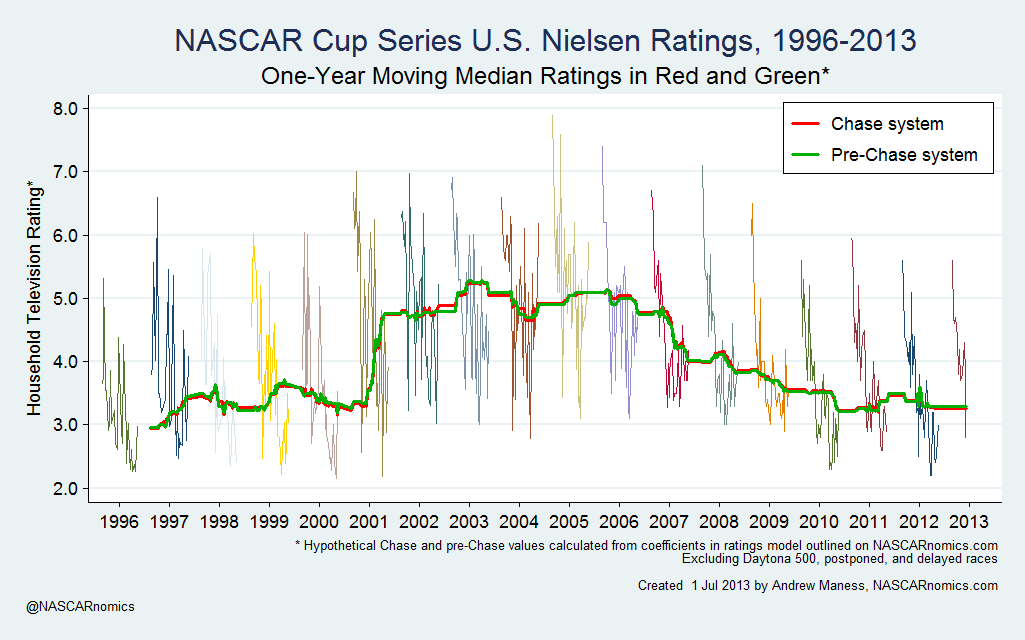 Nope. No major changes occur between either system. The Chase does not affect the size of the household audience in either direction. From an empirical standpoint, I solve the objective of this entry; the Chase has neither augmented nor eroded interest in NASCAR’s Cup Series. Rather, it has simply changed the distribution of ratings throughout the year. But does this mean that the postseason format is a failure? It’s all about perspective, I suppose. NASCAR intended to widen its audience by changing the method to determine the champion of its top series. In that sense, it is a failed initiative after nine seasons. Ratings have not declined due to the Chase, however; so the sanctioning body arguably took a calculated risk that carried a “low-risk/high-reward” payout. And in that case, NASCAR lost little-to-nothing in this gamble.
Nope. No major changes occur between either system. The Chase does not affect the size of the household audience in either direction. From an empirical standpoint, I solve the objective of this entry; the Chase has neither augmented nor eroded interest in NASCAR’s Cup Series. Rather, it has simply changed the distribution of ratings throughout the year. But does this mean that the postseason format is a failure? It’s all about perspective, I suppose. NASCAR intended to widen its audience by changing the method to determine the champion of its top series. In that sense, it is a failed initiative after nine seasons. Ratings have not declined due to the Chase, however; so the sanctioning body arguably took a calculated risk that carried a “low-risk/high-reward” payout. And in that case, NASCAR lost little-to-nothing in this gamble.
This entry was written to present an objective look at the Cup Series’ playoff format and its effect on television ratings. I am curious to know what your opinions are on the Chase. Has it been a failure? Do you enjoy the current method of determining NASCAR’s champion? If not, how might you suggest that the sanctioning body change the points system? It’s obviously a hot-button issue, but I know that NASCARnomics.com readers are typically calm, cool, and collected; thus, I hope a very constructive debate may ensue.
So let the thoughtful debate begin! Feel free to contact me via e-mail, on Twitter, or on “Reddit” with your opinion. Here are links to each point of contact:
- You may contact me via e-mail at
- I hang out on Twitter and post some pretty cool graphs –
- Somebody posted NASCARnomics.com to Reddit; I answer questions on there, too
Thank you for reading. I sincerely appreciate the time you take. These entries are long, but I hope you can take away a new fact or two from them.
Andrew
